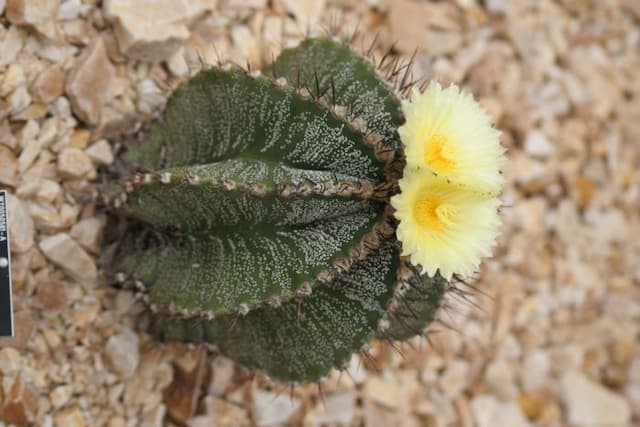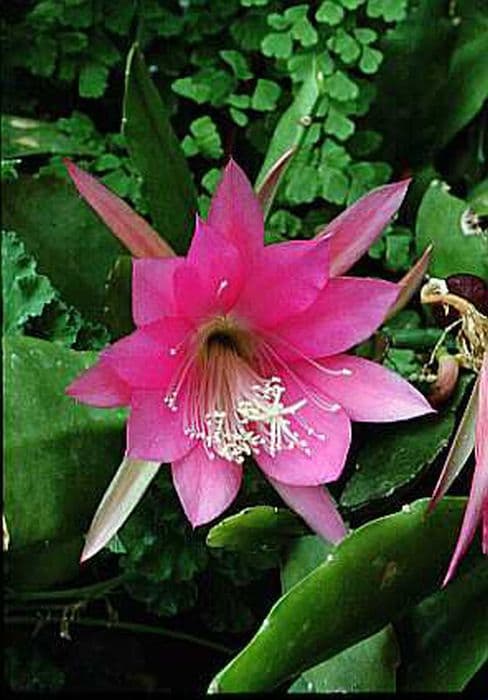Snowball Cactus Mammilloydia candida
ABOUT
Mammilloydia candida, more commonly known as the snowball cactus, is a small, unassuming plant with a distinctive appearance. Its body is comprised of a dense collection of bumps, or tubercles, that are arranged in a spiral pattern. These tubercles give it a somewhat rounded form, contributing to its common name as they can give the impression of a snowball, especially when the plant is viewed from a distance. The coloration of the snowball cactus is predominantly a stark, bright white, which is uncommon among cacti and thus makes it quite distinctive. This white color is due to a dense covering of tiny hairs, which can give it a soft, almost fuzzy appearance and helps to protect the plant from intense sunlight. Although known as hairs, these structures are not soft as one would expect from the term, but rather are more bristle-like. From the body of the snowball cactus, one can occasionally observe small flowers emerging. These flowers are typically a contrasting pink or reddish hue, which provides a striking visual against the white of the plant body. The blooms can certainly catch the eye when present, adding a splash of color to the otherwise monochromatic scheme of the cactus. Apart from its flowers, the snowball cactus does not generally produce any other significant features that are visible above the ground, as it does not typically grow traditional leaves or branches like many other plants. Its root system is adapted to anchor the plant into the rocky and arid habitats where it is usually found, ensuring that it can absorb as much moisture as possible in its challenging environment. Overall, the snowball cactus has a minimalist yet unique charm. Its spherical shape dotted with white tubercles and the occasional colorful bloom makes it a desirable plant for those seeking an unusual and eye-catching addition to their collection of succulents or rock garden specimens.
About this plant
 Names
NamesFamily
Cactaceae
Synonyms
Snowball Cactus, Biznaga de Lima
Common names
Mammillaria candida, Neomammillaria candida, Chilita candida, Ebnerella candida.
 Toxicity
ToxicityTo humans
Snowball Cactus (Mammilloydia candida) is not widely known to be toxic to humans. However, as with many cacti, it is prudent to handle it with care due to its spines. Ingestion of cacti or their parts is typically not recommended, and if parts of this cactus were to be ingested, it could potentially lead to gastrointestinal discomfort, such as nausea or stomach pain, due to the fibrous and indigestible nature of cactus material. There is no significant recorded toxicity in humans specifically from consuming Snowball Cactus.
To pets
Snowball Cactus (Mammilloydia candida) does not have any known specific toxicity to pets. Nonetheless, similar to its effects on humans, ingestion should be avoided for pets as well since the plant's fibrous material and spines can lead to oral irritation, gastrointestinal upset, or obstruction. If a pet were to ingest this cactus, it could experience symptoms such as vomiting, diarrhea, or a decrease in appetite due to irritation of the digestive tract.
 Characteristics
CharacteristicsLife cycle
Perennials
Foliage type
Evergreen
Color of leaves
Green
Flower color
White
Height
6 inches (15 cm)
Spread
6 inches (15 cm)
Plant type
Cactus
Hardiness zones
9
Native area
Mexico
Benefits
 General Benefits
General Benefits- Ornamental Value: Mammillaria candida, commonly known as Snowball Pincushion Cactus, adds aesthetic appeal to gardens and indoor spaces with its distinctive snow-white spines and spherical shape.
- Drought Tolerance: This cactus is highly adapted to dry environments, requiring minimal watering and care, making it suitable for xeriscaping and water-conserving gardens.
- Low Maintenance: Snowball Pincushion Cactus requires little maintenance, making it ideal for busy gardeners or those new to plant care.
- Pollinator Attraction: When in bloom, it produces flowers that can attract pollinators like bees, enhancing biodiversity in the garden.
- Compact Size: Its small size makes it perfect for container gardening, terrariums, and limited spaces.
- Propagation Ease: This plant can be easily propagated from offsets or seeds, allowing for quick multiplication and sharing with other plant enthusiasts.
- Long Lifespan: As a slow-growing cactus, it can live for many years with proper care, providing long-term value as a houseplant or garden specimen.
 Medical Properties
Medical PropertiesThis plant is not used for medical purposes.
 Air-purifying Qualities
Air-purifying QualitiesThis plant is not specifically known for air purifying qualities.
 Other Uses
Other Uses- Snowball Cactus can be used as a living sculpture in minimalist or modern art settings due to its unique spherical shape and lack of spines.
- It can serve as an educational tool for botany students learning about cactus morphology and adaptations in arid environments.
- The Snowball Cactus's compact size makes it suitable for use in space-efficient vertical gardens or living walls.
- It can be used as a natural barrier in a terrarium setup to create separate zones or features within the mini-ecosystem.
- Its unusual form can make it a central piece in themed garden displays, especially in collections highlighting desert flora.
- The Snowball Cactus could be used in stop-motion animation as an object that closely resembles a snowball or a white rock.
- This plant can serve as a white color contrast in gardening to break up the monotony of green foliage and add visual interest.
- Its drought-resistant characteristics could be utilized in educational programs about water conservation and xeriscaping.
- In a photographic still life composition, the Snowball Cactus can add a unique texture and form, enhancing the visual appeal of the art.
- This cactus can also be used as part of a mindfulness practice where individuals focus on its growth and subtle changes as a form of meditation.
Interesting Facts
 Feng Shui
Feng ShuiThe Snowball Cactus is not used in Feng Shui practice.
 Zodiac Sign Compitability
Zodiac Sign CompitabilityThe Snowball Cactus is not used in astrology practice.
 Plant Symbolism
Plant Symbolism- Purity - Mammilloydia candida, commonly known as Snowball Cactus, has a pristine white spherical appearance resembling snowballs, symbolizing cleanliness and innocence.
- Adaptability - As a cactus, the Snowball Cactus represents the ability to thrive in harsh conditions and adapt to challenges, much like it does in its arid natural habitat.
- Resilience - The robust nature of the Snowball Cactus, being able to survive with minimal water, makes it a symbol of toughness and endurance.
- Self-Reliance - This cactus is equipped to store its own water and nutrients, reflecting a spirit of independence and self-sufficiency.
 Water
WaterThe Snowball Cactus should be watered sparingly, as it is susceptible to overwatering. Water deeply but infrequently, allowing the soil to completely dry out between waterings. During the active growing season in spring and summer, watering every 2-3 weeks with about 8-10 ounces of water should be sufficient. In the fall and winter, reduce watering to once a month or less, monitoring the soil dryness before adding more water. Always avoid letting the plant sit in water as it can lead to root rot.
 Light
LightSnowball Cactus thrives best in bright, indirect light. It prefers a spot where it can receive plenty of light without being exposed to the harsh midday sun. East or west-facing windows are an excellent choice, offering the cactus a good balance of light and shade to mimic its natural environment. Direct sunlight, especially during the hottest parts of the day, should be avoided to prevent sunburn.
 Temperature
TemperatureSnowball Cactus enjoys warm temperatures, ideally between 70 to 80 degrees Fahrenheit. It should not be exposed to temperatures below 50 degrees Fahrenheit as it is not cold-hardy. Keep the cactus away from drafts and areas with sudden temperature changes to ensure optimal growth and health.
 Pruning
PruningPruning of the Snowball Cactus is not typically necessary as it naturally maintains a compact shape. However, if any dead or damaged spines or offsets are present, they can be gently removed to improve the plant's appearance and health. Pruning, if needed, should be done in the spring or early summer when the cactus is actively growing.
 Cleaning
CleaningAs needed
 Soil
SoilThe Snowball Cactus prefers a well-draining soil mix, such as a cactus or succulent blend, with pH around 5.5-7.5. A mixture of perlite or pumice with potting soil can work well.
 Repotting
RepottingSnowball Cacti should be repotted every 2-3 years to refresh the soil and provide room for growth. Spring is the ideal time for repotting.
 Humidity & Misting
Humidity & MistingSnowball Cactus thrives in low humidity environments, typical of arid regions it originates from, so household humidity levels are generally adequate.
 Suitable locations
Suitable locationsIndoor
Place Snowball Cactus in bright, indirect light and keep the soil dry.
Outdoor
Grow Snowball Cactus in full sun to partial shade and protect from heavy rain.
Hardiness zone
9-11 USDA
 Life cycle
Life cycleThe Mammilloydia candida, also known as snowball cactus, begins its life cycle as a seed, which germinates when environmental conditions are suitable, typically with warmth and minimal moisture. The seedling stage involves the development of a small taproot and initial spines in place of leaves, which are adapted to the cactus's arid habitat. As it matures, the cactus grows slowly, conserving water and nutrients, and develops a spherical shape with a woolly apex where flowers will eventually emerge. The plant reaches reproductive maturity in a few years, producing white to pinkish flowers that are predominantly self-pollinated, but can also be cross-pollinated by insects. After successful pollination, the flowers develop into small, fleshy fruits containing seeds, which are then dispersed, often by wildlife, to start a new generation. Throughout its life, Mammilloydia candida undergoes periods of dormancy, where growth pauses during unfavorable conditions, followed by active growth with the return of rainfall and warmer temperatures.
 Propogation
PropogationPropogation time
Spring to Summer
The Snowball Cactus (Mammilloydia candida) is typically propagated through the use of seeds. This method is popular due to its simplicity and effectiveness for this particular species. To propagate the Snowball Cactus by seeds, one should sow the seeds in a well-draining soil mix during the warmer months, as higher temperatures favor germination. The soil should be kept moist but not waterlogged, and the containers with seeds should ideally be placed in a location with bright, indirect sunlight. Germination can take several weeks, and once the seedlings are large enough to handle, they can be carefully transplanted into individual pots. This method allows for the creation of new genetically diverse plants, which can contribute to the health and resilience of the cultivated population.









